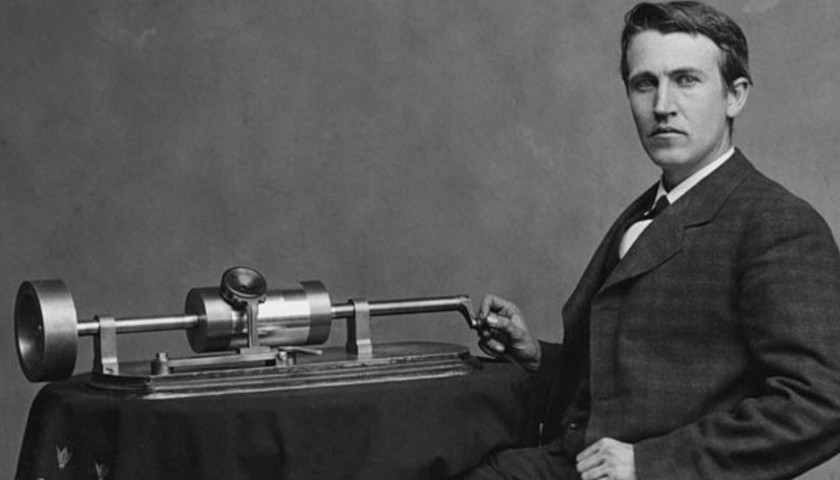Thomas Alva Edison, born February 11, 1847 in Milan, Ohio, was fired from two jobs before the age of 18 for causing explosions in his places of work.
From a very early age, Edison demonstrated a strong entrepreneurial spirit, a desire for autonomy, and an eagerness to improve the way things worked—all characteristics that would earn him the title of father of the modern world.
Edison had two “brief stints” in public schools but didn’t do well in the traditional school setting, according to Edison biographer Randall E. Stross. Teachers complained that Edison was a nuisance in the classroom and he was often punished for asking too many questions, the Thomas Edison Center at Menlo Park reveals.
So at the age of 12 his mother pulled him from the public schools and decided to homeschool her son, which constituted the majority of his education, though he didn’t receive much formal instruction.
Early Laboratories and inventions
Edison set up his own laboratory in his room and began performing original experiments after his mother introduced him to the book, The School of Natural Philosophy. His parents eventually asked him to move his in-home laboratory to the basement because he was making a mess of his room.
It’s said that the explosions from his basement lab frequently shook the house, upsetting his father. He soon realized that he needed money to fund his experiments and so he persuaded his mother to end his home-schooling and took up a job with the Grand Trunk Railway. His family had moved to Port Huron, Michigan by this time and Edison began working as a newsboy on a route from Port Huron to Detroit.
According to Stross’ account, this is when Edison’s entrepreneurial talents began to shine:
“Once on board, he saw that he could buy goods cheaply in the big city and retail them in little Port Huron at a nice markup. He opened two stores—a newsstand and a fresh-produce stand—and hired two other boys to staff them and share in the profits.
By 15, still working for the railway, Edison began publishing newspapers using a gallery-proof press that he set up in the baggage car of the train. Legend has it that this was the first newspaper in the world to be printed on a moving train.
But all of these business ventures were secondary to Edison’s inventions. In fact, to occupy his spare time on the trip from Port Huron to Detroit, Edison also set up a chemical laboratory in the baggage car of the train, but he was fired after a bottle of phosphorous fell to the floor and set the car on fire, Stross recalls.
Edison was more interested in the working of the telegraph, anyway, and he built one for himself to study at home. At 16-years-old, Edison started working as a telegraph operator in Port Huron’s telegraph office, but he was later fired from this job as well after one of his experiments nearly blew up the office.
For the next five years, Edison traveled around the country working as a telegraph operator and became one of the most highly-skilled operators, but he didn’t enjoy it much. According to Stross, Edison was “increasingly devoting time to tinkering with telegraphic apparatus, looking for ways to gain speed, in sending and mechanically printing messages.” He used abandoned equipment for his experiments and invested his wages into buying new tools.
In December 1868, he decided to quit working and devote himself to his inventions. The following year, he patented the Electrical Vote Recorder for use by the U.S. Congress and state legislatures. He also created the “stock ticker” around this time, which received “up-to-date stock price information from the stock exchange and displayed it at various locations,” according to the Thomas Edison Center.
Edison soon found himself working for Western Union and was put in charge of all of their equipment. After impressing his boss, the company offered to buy out all of his inventions and improvements to their system for a price of $40,000, which Edison used to set up his first workshop in an empty factory building in Newark.
Menlo Park
In 1876, Edison wanted to move from the city so he could have a larger space for an inventions workshop. He settled on two parcels of land in Menlo Park, New Jersey. His father helped build the main laboratory, while Edison built “other ancillary buildings including the glass house, a carpenters’ shop, a carbon shed, and a blacksmith shop,” according to the historical center that maintains this site.
It was the world’s first research facility, and it was here that Edison came up with the revolutionary idea of recording the human voice. By November 1877, he completed his first phonograph, which catapulted the young inventor to world fame.
His next project was the creation of a successful incandescent light bulb. By 1879, he had completed a bulb that could burn for up to 40 hours and went on to establish the Edison Electric Light Company, devoted entirely to finding new uses for electricity. In 1882, for instance, he built a generator plant on Pearl Street in New York and installed nearly 400 bulbs in homes and buildings throughout the area. Hundreds gathered to watch as Edison turned on the generator and lit the street with electricity. He had proven his theory that a central generator could provide power in bulk.
According to the Thomas A. Edison Papers at Rutgers University, Edison executed 1,093 successful U.S. patent applications throughout his career. Tourists from around the world flocked to his New Jersey workshop to witness firsthand the “Wizard of Menlo Park.”
– – –
Anthony Gockowski is managing editor of Battleground State News, The Ohio Star, and The Minnesota Sun. Follow Anthony on Twitter. Email tips to [email protected].




